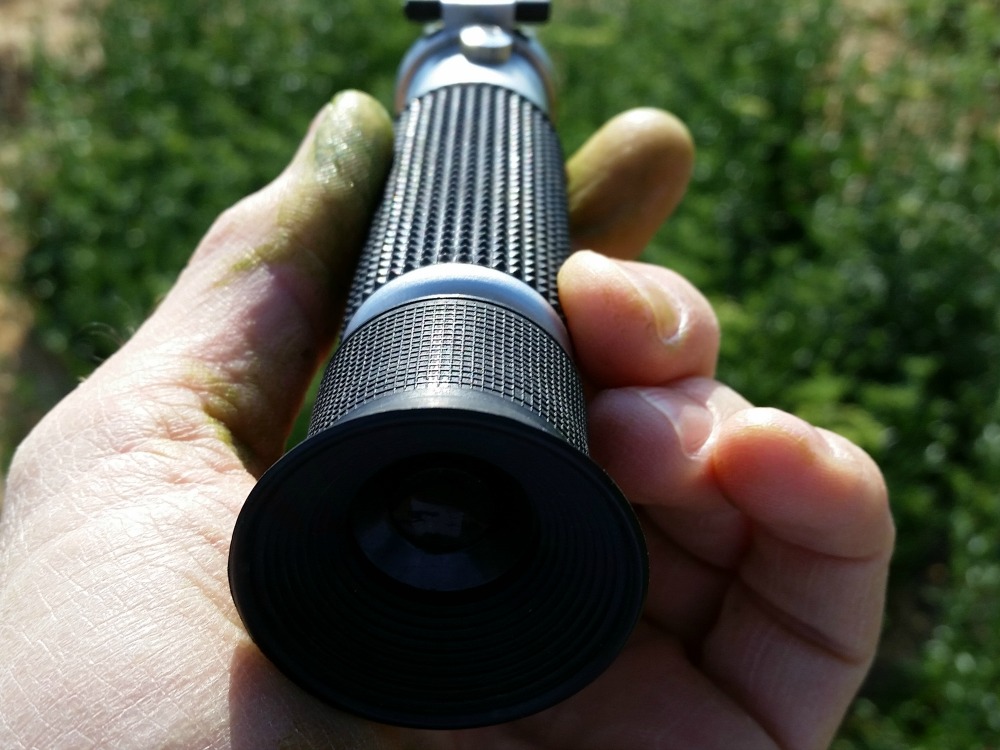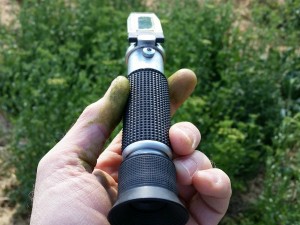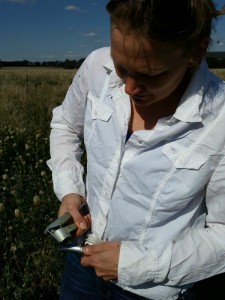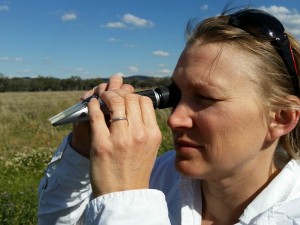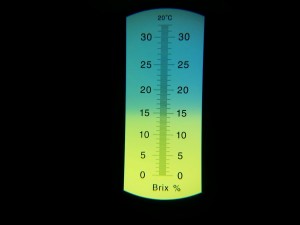What do you reply when you are asked what you do? Maybe that you produce corn, wheat, lamb, beef, wool or chickpeas?
Yes, we farmers ARE doing these things, but we are actually in the business of maximising the capture of light energy from the sun, for the production of chemical energy and sugars in the plant. With these sugars we want to maximise our food and fibre production, because this is our profitability. And, as regenerative farmers, we want to do this whilst increasing the quality of our asset base (soil, farm environment and our team).
So, the sugar levels in the plant are like a gauge of photosynthetic activity. They are also a gauge of the health of the plant; the higher the sugar levels – the healthier the plant. A determination of the plant’s sugar levels, (as well as other dissolved solids like minerals) is measured as Brix.
Measuring brix levels is a helpful thing to do because it is very quick to do and gives us clues as to the health of the plant and the subsequent likelihood of insect pest attack, frost susceptibility, possible plant growth limitations and more. If higher brix levels can have such benefits to us and our crops, then we also want to know how we can increase brix levels.What is brix?
Brix is a measure of the dissolved solids of a liquid. Brix predominantly measures the sugar content of a liquid (in our case plant sap). “Brix is mostly a measure of sugars and minerals dissolved in water, however many other chemicals may be present and contribute some small factor to the Brix reading.”1 These may include amino acids, lipids, and any suspended particles or colloids2.
Brix is measured on a scale that quantifies the amount of light that is bent (or refracted) when passing through a liquid. The amount of light refraction depends on the density of the liquid (which is influenced by the things mentioned above – predominantly sugar). The unit of measure is degrees Brix (oBx). ie. 1 gram of dissolved solids per 100 grams of solution. Brix levels in broadacre crops and pastures will generally vary from around 4 to 20. It is a refractometer that we can use to measure these levels, but more on that later.
Let’s take a look at what higher brix levels in our plants can offer.
Frost Protection
Plants that have higher brix levels are less prone to frost. This is because high brix plant sap has a lower freezing point than low brix sap.
We know that “pure water freezes at 0oC (32oF). However, a 5 brix water-sugar mixture freezes at -3.3oC (26oF); a 10 brix mixture at -5.5oC (22oF); and a 15 brix mixture won’t freeze until it reaches -8oC (17oF).”3 While the freezing points referred to are for sugar water – not exactly the same as sap/plant brix levels – it does give a clear indication of the effect that brix can have on frost susceptibility.
Even main stream agriculture knows the benefits of high brix. Consider these comments from Pulse Australia – “Increase plant carbohydrate (sugar) levels because higher levels of carbohydrates in plants during a frost event means less leakage, hence damage during thawing. Biological farmers measure “Brix levels” with a refractometer. Crops with a higher sugar content (high Brix) will also have a lower freezing point, with an associated protection against frost damage. A high Brix reading means higher sugar and mineral content, higher true protein content, a greater specific gravity or density, and a lower nitrate and water content for better storage characteristics.”4
resistance to Insect and Disease Attack
Plants with higher brix readings are more resilient to disease and insect attack. Dr Callahan, previous entomologist with the University of Florida reports that insects detect various wavelengths in the infrared spectrum. They relate these different frequencies to food, mates, water etc. Plants that are have good mineral balance emit a different frequency to those that have deficiencies.5 “ Once the quality of a crop surpasses a given level, there will not be an insect problem with it because the crop will not vibrate at a frequency corresponding to the insect’s food.”6
“As a general rule of thumb, 12 or better brix readings confer reasonable plant pest immunity. This is true for both fruit and leaf readings.” “You will find pest problems persist until you achieve higher leaf and stalk readings – the target is always 12+.”7
I have previously been aware of the relationship between brix and protection from insect attack, but this next bit is fascinating – and something I wasn’t so clear on until doing the research for this blog.
John Kempf, crop nutrition consultant with Advancing Eco Agriculture in the US, has noticed and reported on 4 stages of crop health improvement over time, upon moving from a chemical intensive system to a biological based farming system.8
Kempf says that to have a properly functioning plant, with immunity to diseases and attack from insects, the plant must be able to form complex carbohydrates, lipids and complex proteins. The four phases he refers to are:
Phase 1 – Carbohydrate production & resistance to soil pathogens
The first phase is that of complete production of carbohydrates. At this stage, all the inputs for plant growth and photosynthesis (sunlight, water, air and minerals) are all present and simple sugars or monosaccharides such as fructose and sucrose are produced by the plant. More complex polysaccharide sugars such as cellulose, pectins, lignin and starches (which all store carbohydrates) are produced as this process improves.
In Kempf’s experience, if this phase is functioning well, with good photosynthetic activity, the plants will not suffer from soil pathogens and fungi such as fusarium and verticillium.
Phase 2 – Protein production and resistance to insects
As photosynthesis activity increases, greater amounts of plant sugars are transferred out through the roots, to feed soil microbes, which in turn, make minerals available to the plant. These minerals act as coenzymes in the production of complex carbohydrates and especially amino acids which go on to be peptides, which then go on to form proteins. In the absence of these minerals as coenzymes, the plant is unable to form these complex proteins and the plant has high levels of amino acids (the precursor to protein) in the sap, which insects can readily feed on. The simplicity of many insects’ digestive systems means they cannot digest complex proteins, but the amino acids they can. Kempf refers to resistence against aphids, whitefly and other larval insects at this phase.
As I have described in other blogs, when synthetic fertilisers are applied to crops, the plant’s need to feed sugars out through its root system to feed soil microbes for the purpose of seeking minerals is reduced and the need for energy from photosynthesis is also reduced. These plant root exudates are what feed the soil microbes, that in turn make some of the little recognised micronutrients available, which are crutial for the coenzymes mentioned above.
Phase 3 – Fat storage and resistance to airborne pathogens
“As photosynthetic energy and efficiency increases, plants develop a surplus of energy beyond that needed for basic growth and reproduction. Initially, large quantities of this surplus energy, in the form of sugars, are translocated to the root system, as high as 70% of the total sugar production. Later, the plant begins to store this surplus energy in the form of lipids – plant fats – in both vegetative and reproduction tissue.”9
The phospho lipid cell membranes of plants are built from these plant fats. The higher the energy and fat levels of the plant, the stronger this membrane becomes and the more able the plant is to resist airborne pathogens. Kempf refers to plant resistance to powdery mildew, rusts, scabs and other airborne fungal diseases around this phase. He stresses the need for a functioning soil microbe community if the plant is to function in this phase.
Phase 4 – Plant Protectants and Beetle protection
I mentioned in phase 2 that some insects have simplified digestive systems which mean they cannot digest complex proteins. There are some beetles however that can, and it is not until this final phase is reached in plant growth that John Kempf believes the protection from these will come. The plant does this by taking the ample lipid levels from phase 3 and produces plant protectant compounds. These are things such as bioflavonoids, carotanoids, tannins, terpenoids and they contain anti-fungal, anti-bacterial properties and digestion inhibiting enzymes.
It is predominantly the beetle family that have a more developed digestive system and which are the final pest group protected against when plant health reaches this phase 4 – as identified by John Kempf.
Experience would tell us that it may take some years of amending soil and farming systems to achieve a phase 4 plant. As plants move to a higher phase of health, one would expect this would be reflected in Plant brix levels – but what levels?? I quizzed John Kempf on this, and he informs me that they have developed algorithms to predict likely insect or disease susceptibility with a high degree of accuracy, and this is based on the nutrient ratios contained with the leaf sap (a little more complex than brix). These algorithms haven’t been published yet, but I look forward to learning more from John and will share it with you when I do.
Food Quality
Higher brix produce is higher in sugar, minerals and vitamins and therefore tastes better – they’re sweeter! Being more minerally dense, this produce is obviously also better for our health when we consume it. In writing this however, I have also recognised something else. What many of you may not know is that I am also passionate about preventative and regenerative human health. In my many readings and gleaning from those in the field, I have learnt that each time we eat, it is important to have adequate carbohydrates available to provide the energy to help digest the other things like proteins and fats. This might be pumpkin (carbohydrate) with your steak (protein) meal, or a small glass of orange juice (carbohydrate) with an omelette (protein). In the absence of such carbohydrates in our meal, the body draws sugars from the liver (where they are stored), to provide immediate energy to help with digestion. Long term stress lowers these liver stores of sugar and leaves us reliant on that which is in the food.
I’ve always considered the above information with regard to what food groups I choose to put together at eating times, but now my thoughts have broadened to consider the carbohydrates WITHIN each food stuff. In eating low brix food, my tomatoes, zucchinis etc are not supplying the energy (via carbohydrates/sugars) to help with the digestion of the same mentioned food – as well as the accompanying protein or fats.
So, one would think that high brix food would be more readily digestible, as well as tasting better and having higher nutrient value.
Measuring brix
We can measure the brix levels of plant sap using a refractometer. A simple hand held device.
A garlic crush does a great job of crushing the sap out, which can be dropped on the screen of the refractometer and the plastic illuminator flap can be lowered onto the sample/screen.
The viewfinder can then be looked through.
Now, I’d like to tell you that I measured the arrowleaf clover in the background of the top photo and got some fantastic results, but the truth is it’s pretty dry here now, and I couldn’t get enough sap for a measurement! So it was off to the vegetable patch for my example for you!
I was pleased however to get the following reading from our parsley plant. (This is what you will see through the viewfinder). There are brix tables available which indicate brix levels for plants as poor, average, good and excellent. Anything above 10 is excellent for parsley – and this a 15!
So, a reading of around 15. The fact that the line is blurry indicates better quality proteins/more minerally dense (especially calcium) sap. “As a general rule of thumb, 12 or better brix readings confer reasonable plant pest immunity. This is true for both fruit and leaf readings.”6 “You will find pest problems persist until you achieve higher leaf and stalk readings – the target is always 12+.”
I then grabbed a store bought capsicum that I had in the fridge and you can see the result below. Hmmmm…. Notice the sharpness of the line – as well as the obvious low reading. Note to self – ensure more production from the vegetable patch!
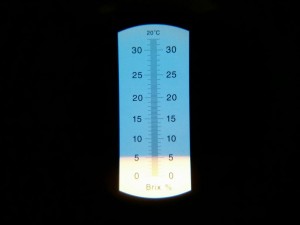
If you are to measure brix yourself there are a few other details you should know about, such as calibration which I won’t cover here but are easily found out. Call me if you would like more information.
How do we increase our Brix levels?
Rebalancing our soils and increasing microbial activity will help to improve brix levels in plants (with calcium reportedly quite important). Any activity that promotes photosynthesis and the natural flow of plant sugars to the root system to feed the soil microbes will likely be a positive for brix levels. Soil microbes will help to make micronutrients available – their importance in coenzymes of which I have already mentioned. Think planned grazing, pasture cropping and any activities that are supportive of the soil biology. Chemical intensive systems with high rates of synthetic nitrogen fertilisers will not.
It should be noted that the brix level of the plant is just a guide to us. It is a reflection of the environment in which the plant is growing – and of the soil particularly. Using brix levels in conjunction with soil tests and/or other monitoring techniques is suggested. After all, if levels are low – the horse has somewhat bolted – as it is a reflection of growth to date. Having said this however, if a foliar application of fertiliser is planned on a crop, measure brix levels and then spray small test plots of the crop with different likely fertilisers. Retest the plots to see which fertiliser will provide the biggest increase in brix and will therefore be the best choice for crop production.
Gabe Brown of North Dakota who I spoke with a few months back about multi species cover cropping reports brix levels of 20 and over! These are really tremendous levels and reflect the health of the system he is farming. If you are a new to The Conscious Farmer, are a cropper and haven’t read my blogs on multi species cover cropping I suggest that you do. (Just search cover cropping at the top of the side bar). Colin Seis has also had similar brix outcomes from his pasture cropping.
In summary
I find that when I start researching a topic, it leads me to always question ‘why’, as I want to understand the science behind things. In this week’s case, brix and refractometers aside, it’s led us to have an increased understanding of the natural defense mechanisms of plants. When we better understand such things, we can make more informed decisions about our farm practices.
Have you had any experiences with measuring Brix?
References
1 & 4. Brix. Bionutrient Food Association. http://bionutrient.org/bionutrient-rich-food/brix 14th Oct, 2014.
2. The Use of Refractometers. Integrity Soils. http://www.integritysoils.co.nz/tag/photosynthesis/ 15th Sept, 2014.
3& 6. Harrill, R. Using a Refractometer to Test the Quality of Fruit and Vegetables. (1994). http://www.crossroads.ws/brixbook/BBook.htm#GENTLE WARNING
4. Pulse Australia. Australian Pulse Bulletin – Managing Pulses to Minimize Frost Damage. http://www.pulseaus.com.au/pdf/Managing%20Pulse%20to%20Minimize%20Frost%20Damage.pdf?zoom_highlight=VIRUS+MANAGEMENT+IN+PULSES
5&7. Morand,O. (2013) How Plants Repel Insects – an Observation of Monarchs, Brix and Nutrient Dense Plants. The Permaculture Research Institute. http://permaculturenews.org/2013/05/29/how-plants-repel-insects-an-observation-of-monarchs-brix-and-nutrient-dense-plants/
8 & 9 Kempf, J. Crop Health Transitions. http://bionutrient.org/audio/2013_soil_nutrition_conference/2-Crop-HEALTH-Transitions-John-Kempf.pdf 17th Oct 2014.

